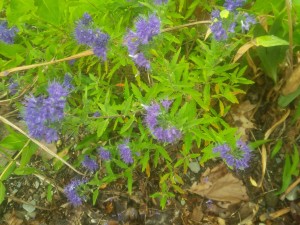
An old French fairy tale recounts the heinous exploits of Blue Beard, a nobleman with an imposing castle and a penchant for murdering his wives. Outwitted by his final wife and dispatched by members of her family, Blue Beard lived and died by the sword. Clearly, they don’t make fairy tales like they used to.
Blue Beard’s namesake plant, known in Latin as Caryopteris, has no violent tendencies. It is a small, graceful, deciduous shrub with “beards” that are actually terminal clusters of tiny, intensely blue or blue-purple flowers. As befits such a beautiful plant, it has other, more benign nicknames, including “blue mist shrub” and “blue spirea”. It offers up those blue flowers at the end of summer, right alongside roses-of-Sharon and butterfly bushes in their second or third flush of bloom. No matter what you call it, bluebeard is an extremely useful addition to small or large gardens or container planting schemes. It is well mannered enough for a mixed annual/perennial/shrub border, but attractive enough to stand on its own during the growing season.
The ancestors of today’s commercial, mostly hybrid caryopteris were native to Asia. The first species to find its way to the West was one of those ancestors, Caryopteris incana, which was introduced to England from China by a famous plant hunter, Robert Fortune, in 1844. It was judged to be so tender that it was propagated and cosseted in greenhouses. About forty years later, another celebrated plant hunter, Charles Maries, found a hardier Caryopteris incana in Japan and shipped plants back to England. The plants entered the gardens of enthusiasts, which led to another leap towards commercial viability. In about 1930, a third Englishman, Arthur Simmonds, found a chance seedling amid the caryopteris species in his garden. Further propagation led to the appearance of a very strong hybrid offspring, which was eventually christened Caryopteris x clandonensis, after Clandon, the town nearest Simmond’s home. It took another fifty years or so, but eventually, in the last decades of the twentieth century, breeders and merchandisers realized the potential of bluebeard and the number of clandonensis hybrids on the market increased dramatically.
Bluebeard shrubs grow between two and four feet tall and wide, depending on the variety. Though the plants are officially classified as shrubs, the stems are slender and flexible. Clandonensis leaves, which can be green, gray-green, golden-green or variegated with cream margins, are oval-shaped, with “toothed” or serrated leaf edges. If you rub those leaves and sniff, you will notice another of the plant’s assets, a pleasant, eucalyptus-like fragrance that also exudes from the stems. This aromatic quality links bluebeard to its many relatives in the mint or Lamiaceae family.
Strongly scented leaves repel deer and other marauders, but it is the flowers that attract butterflies and other pollinating insects, not to mention humans. Borne in rounded flowerheads at the tops or ends of each branch, the individual flowers are notable for their prominent, projecting stamens. The “blue mist” of those flowers may be the very dark blue of ‘Dark Knight’, the medium blue of the old standard, ‘Longwood Blue’, or the lighter shade of ‘Summer Sorbet’. For a shot of medium blue in smaller gardens and containers, try ‘Petit Bleu’ or ‘Heavenly Baby’, both of which top out at about 24 inches tall and wide. Ten years ago, the Royal Horticultural Society noted that there were over 20 cultivated varieties of Caryopteris listed in their Plant Finder. The number is almost certainly much larger now, though many are only available through specialist nurseries.
Still, I bought my variegated bluebeard at a big box store several years ago and it has flourished in my front “hell strip” ever since. This demonstrates how completely unfussy bluebeard really is. Provide the shrubs with a sunny spot and water only when they have been without rain for a few days. Depending on your climate and the harshness of the winter, bluebeard may die back completely or partially during the cold months. If the plant seems dead in spring, wait a bit. It will most likely resprout from the roots. If the stems survive the winter, tidy them up and promote abundant flowering by cutting the branches back by one third in the early spring. Since bluebeard blooms on new wood, this will not affect the flowers at all.
If you want bluebeard in your garden twelve months from now, plant one or more of them within the next few weeks. You may be able to find one or two varieties at local garden centers. For a more comprehensive selection, try Forest Farm, 14643 Watergap Rd, Williams, OR 97544; (541)-846-7269; www.forestfarm.com. Free print catalog, with the most complete listings available online.

